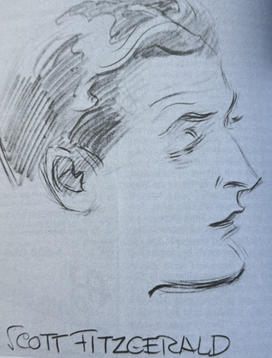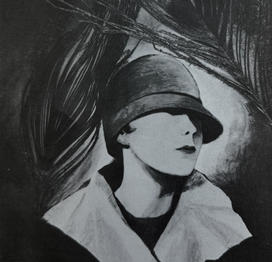Fitzgeraldiana, A Newly Published Story
In 1937, F. Scott Fitzgerald was alone and in debt. His wife Zelda had been committed to a mental hospital, and he found himself living in a hotel in North Carolina, struggling to write fiction that magazine editors would buy. He wasn’t succeeding. Esquire had bought a few stories for a small amount of money, but his work had otherwise gone unpublished for almost a year, and he was having to borrow money from both his publisher, Charles Scribner, and his literary agent, Harold Ober.

His talent seemed to have deserted him, or perhaps the era that his talent epitomized had passed. For years, he had written sparkling stories about glamorous jazz-age heroines and had sold them to slick magazines like the Saturday Evening Post. That style and subject matter, however, no longer gave energy to his imagination. In an autobiographical essay, “Afternoon of an Author,” he described his growing sense of fatigue. “The problem was a magazine story that had become so thin in the middle that it was about to blow away. The plot was like climbing endless stairs, he [the author] had no element of surprise in reserve, and the characters who started so bravely day-before-yesterday couldn’t have qualified for a newspaper serial.”
Nevertheless, he continued to write. In March, he sent a draft of a story called “The Vanished Girl” to Ober, begging him to find someone to publish it. “It had been struggle a plenty to get this out—a good eight hours a day for five weeks,” he wrote. “This is the only one of four starts to come through at all. I am well. Not pessimistic and doing my level best. Including being two mos. on the absolute wagon and the next one will as usual try to be a [Saturday Evening] Post story but this one just had to be sacrificed for immediate gold …. Tell them anything, tell them frankly that you’ve advanced me the limit but for Gods sake raise me something on this story and wire it to Baltimore.”
Fifty years later, in the Winter 1988 issue of the Princeton University Library Chronicle, Fitzgerald’s story has been published for the first time, in a revised version titled “A Full Life.” The original draft of the story couldn’t be sold. It was different from Fitzgerald’s jazz-age tales—at once somber and bizarre. It featured, for example, a young woman, dressed in an inflated rubber flying suit, jumping out of a skyscraper window. Ober sent the manuscript back to Fitzgerald and asked him to revise it, telling him that an editor had rejected the manuscript because “this story is too crazy for him.”
Fitzgerald rewrote the story, but it seems to have remained too crazy. Gwendolyn Davies, the woman in the flying suit, has the kind of willful beauty that seems almost to be the equivalent of money. The doctor who tends her after her fall quickly becomes obsessed with her. He remains “forever haunted by the picture of the girl floating slowly out over the city at dusk, buoyed up by delicious air, by a quintessence of golden hope, like a soaring and unstable stock issue.” He keeps track of her whereabouts by reading newspaper reports, from which he learns that, after marrying Cornelius B. Hasbrouk and then the Comte de Frejus, she jumped from the deck of an ocean liner for no apparent reason. She survives the jump, and eventually the doctor finds her performing as a human cannonball in a traveling circus. When he confronts her, she tells him that her costume is loaded with dynamite; when he persists, she blows herself up.
Marie Shank, Fitzgerald’s secretary in 1937, saved copies of his working drafts. Eventually, she donated them to Firestone Library, where they were included among Fitzgerald’s papers. Ten years ago, James L. W. West, a professor of English at Pennsylvania State University, was browsing through the Fitzgerald archive when he came across “A Full Life.” After reading it, he realized that he had made a discovery, of sorts: the story had never before been published.
At first, West couldn’t decide what to do with the story. “I though about it,” he said, “and did some research on it. Finally, I decided that it should be published.” He got permission to publish from Fitzgerald’s literary executors, who hold the copyright, and wrote an article to accompany the story. Although he acknowledges that the story has a little literary merit, West argues that “A Full Life” is important to Fitzgerald’s literary biography. Gwendolyn’s death by explosion, he writes, is a kind of grisly private joke that Fitzgerald made to exorcise himself of his glamorous jazz-age heroines.
For Fitzgerald, however, the flapper’s self-destruction seems to have been implicit in all his stories, even those from the very beginning of his career. In 1937, he wrote an essay called “Early Success,” in which he gave his own account of his work and reputation in the 1920s. “All the stories that came into my head had a touch of disaster in them,” he wrote. “The lovely young creatures in my novels went to ruin, the diamond mountains of my stories blew up, my millionaires were as beautiful and damned as Thomas Hardy’s peasants. In life these things hadn’t happened yet, but I was pretty sure living wasn’t the reckless, careless business these people thought—this generation just younger than me.”
A Museum in Montgomery
When Julian McPhillips ’68 and his wife Leslie discovered last year that the building two houses down the street from their home was for sale, they decided to buy it. McPhillips, an attorney in Montgomery, Alabama, wasn’t interested in moving into the 6,500-square-foot house; rather, he wanted to preserve a bit of history. His aspiration had led to the creation of the first museum devoted to Zelda and F. Scott Fitzgerald.

The Fitzgeralds and their daughter, Scottie, lived in the house on Felder Avenue in the Cloverdale section of Montgomery for only a few months, from September 1931 to April 1932. Even so, the house holds a place in literary history: Scott worked on his novel Tender is the Night during that period, and Zelda, a native of Montgomery, began her only novel, Save Me the Waltz, there. Since there isn’t a museum dedicated to the Fitzgeralds anywhere McPhillips reasoned that the Montgomery house would be ideal for that purpose.
"There's a Faulkner Museum in Oxford, Mississippi, and a Poe Museum in Richmond, and a Hemingway Museum , but very little is dedicated to Fitzgerald, " McPhillips says. "There's a plaque at his birthplace in St. Paul , and one at the graveyard in Maryland where he and Zelda are buried. It seemed to us that it would be appropriate to honor this couple, who symbolized an important period in this country's history."
Another reason for buying the house, McPhillips says , was to rescue the place from developers. "The house is on an acre and a half of prime real estate in Montgomery—more than eight city lots—and a lot of people were eager to develop it," he says. "We couldn't allow them to tear it down."
To organize the museum, he and his wife started a nonprofit corporation. In Princeton, they researched the Fitzgeralds in Firestone Library’s Fitzgerald archive. They found eighteen people interested enough to join the board of directors. Scott and Zelda Fitzgerald’s three grandchildren agreed to support the project and are honorary directors. In setting up their first exhibit, they got some help from the Montgomery Museum of Fine Arts, and they succeeded in getting the Alabama State Historical Commission to designate the house a historic landmark. The board has collected a modest amount of Fitzgerald memorabilia; eventually, they hope to open the museum as a permanent attraction.
“The house now is a lot different from the way it was when Scott and Zelda lived there,” McPhillips says. “It’s divided into four apartments, but the largest one, which will house the museum, still has original tile and French windows from the Fitzgerald era.” At a recent open house to publicize the venture, McPhillips filled the space with period furniture and mannequins in period dress. He covered the walls with quotations from Fitzgerald.
The problem now, McPhillips says, is to increase the young museum’s collection of Fitzgerald memorabilia. Portraits of Scott and Zelda have been commissioned, and McPhillips says that he is interested in expanding the museum’s holding with anything related to the Fitzgeralds.
“There’s been a great deal of interest down here, and my hope is that the Princeton community will be interested also," he says . "We're nonprofit and need all the support we can get." Those interested in assisting the museum's efforts can contact him at 831 Felder Avenue, Montgomery, AL 36101.
This was originally published in the Feb. 24, 1988, issue of PAW.











No responses yet